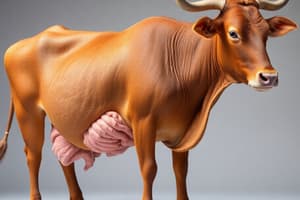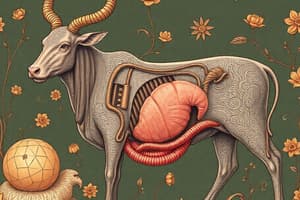Podcast
Questions and Answers
What is the main difference in the stomach structure between pseudo-ruminants and monogastric animals?
What is the main difference in the stomach structure between pseudo-ruminants and monogastric animals?
- Pseudo-ruminants have enzymes for protein digestion, while monogastric animals lack these enzymes.
- Pseudo-ruminants have multiple stomach compartments, while monogastric animals have a single stomach compartment.
- Pseudo-ruminants have a simple stomach, while monogastric animals have a complex stomach.
- Pseudo-ruminants can regurgitate their food, while monogastric animals cannot. (correct)
Which type of animal does not produce enzymes for protein digestion?
Which type of animal does not produce enzymes for protein digestion?
- Omnivores
- Ruminants (correct)
- Carnivores
- Herbivores
What is the main purpose of coprophagy/caecotrophy in some pseudo-ruminant animals?
What is the main purpose of coprophagy/caecotrophy in some pseudo-ruminant animals?
- To reingest food for further digestion (correct)
- To obtain essential nutrients from their feces
- To remove toxic compounds from their system
- To increase the absorption of cellulose
In which part of the gastrointestinal tract do carnivores rely mainly on enzymatic processes for digestion?
In which part of the gastrointestinal tract do carnivores rely mainly on enzymatic processes for digestion?
What is the primary function of peristalsis in animals with simple stomach structures?
What is the primary function of peristalsis in animals with simple stomach structures?
Which type of animal relies on microbial breakdown of plant material in the large intestine?
Which type of animal relies on microbial breakdown of plant material in the large intestine?
What is a characteristic of ruminant animals' stomach compartments?
What is a characteristic of ruminant animals' stomach compartments?
Which process of breaking down fibre-rich feeds into volatile fatty acids occurs in the stomach compartments of ruminant animals?
Which process of breaking down fibre-rich feeds into volatile fatty acids occurs in the stomach compartments of ruminant animals?
What is the main function of peristalsis in the gastrointestinal system?
What is the main function of peristalsis in the gastrointestinal system?
Do pseudo-ruminants regurgitate their food like true ruminants do?
Do pseudo-ruminants regurgitate their food like true ruminants do?
What is the term for the practice of consuming feces to extract additional nutrients in some pseudo-ruminant animals?
What is the term for the practice of consuming feces to extract additional nutrients in some pseudo-ruminant animals?
In non-ruminant mammals, how is cellulose digestion primarily facilitated?
In non-ruminant mammals, how is cellulose digestion primarily facilitated?
Which animal has a digestive system with a structure similar to that of a ruminant but does not exhibit regurgitation?
Which animal has a digestive system with a structure similar to that of a ruminant but does not exhibit regurgitation?
'Eructation' refers to which process in the digestive system of ruminant animals?
'Eructation' refers to which process in the digestive system of ruminant animals?
Which animal category has a simple stomach and relies on microbial breakdown for digestion?
Which animal category has a simple stomach and relies on microbial breakdown for digestion?
What is the primary function of rumination in ruminant animals?
What is the primary function of rumination in ruminant animals?
In the context of digestion, what does 'selective retention of particles at the reticulo-omasum orifice' help in?
In the context of digestion, what does 'selective retention of particles at the reticulo-omasum orifice' help in?
Flashcards
Ruminant Animals
Ruminant Animals
Animals whose stomach is divided into the rumen, reticulum, omasum, and abomasum, allowing digestion of high-cellulose herbage.
VFAs in Ruminants
VFAs in Ruminants
Volatile fatty acids (acetic, propionic, and butyric acids) produced by bacteria and protozoa during the fermentation of fiber in ruminants.
Advantages of Ruminant Pre-Gastric Fermentation
Advantages of Ruminant Pre-Gastric Fermentation
The breakdown of fibrous feeds into VFAs, synthesis of vitamins and amino acids, and microbial protein production in the rumen.
Pseudo-Ruminants
Pseudo-Ruminants
Signup and view all the flashcards
Monogastric Farm Animals
Monogastric Farm Animals
Signup and view all the flashcards
Non-Ruminant Herbivores
Non-Ruminant Herbivores
Signup and view all the flashcards
Carnivores
Carnivores
Signup and view all the flashcards
Omnivores
Omnivores
Signup and view all the flashcards
Coprophagy/Caecotrophy
Coprophagy/Caecotrophy
Signup and view all the flashcards
Meat Animals
Meat Animals
Signup and view all the flashcards
Dairy Animals
Dairy Animals
Signup and view all the flashcards
Work Animals
Work Animals
Signup and view all the flashcards
Study Notes
Ruminant Animals
- Stomach is sectioned into rumen, reticulum, omasum, and abomasum, enabling digestion of leaves, grasses, shrubs, and other herbage high in cellulose and hemi-cellulose.
- Fibre fractions of these plants are broken down into three short-chain volatile fatty acids (VFAs: acetic, propionic, and butyric acids) by bacteria and protozoans through fermentation.
- Four-chambered stomach: cattle, sheep, goats, deer, and giraffes.
- Three-chambered stomachs: okapis, pronghorn, camels.
Advantages of Ruminant Pre-Gastric Fermentation
- Breaks down fibrous feeds into VFAs, synthesizes vitamins and amino acids, and protein in the rumen.
- Synthesizes rumen microbial protein by rumen microbes.
- Selective retention of particles occurs at the reticulo-omasum orifice, and mechanical breakdown of fibres during rumination enhances digestion of coarse foods.
- Large quantities of gas produced can be readily released from the system by eructation (belching).
Pseudo-Ruminants and Monogastric Farm Animals
- Pseudo-Ruminants: animals with simple stomachs that feed on grasses and other materials but do not regurgitate.
- Examples: okapis, pronghorn, camels.
- Monogastric Farm Animals: have a simple stomach with a single stomach compartment.
- Examples: pigs, poultry (chickens, ducks, turkeys, guinea-fowl, and geese).
Non-Ruminant Herbivores
- Herbivores that feed on plant materials, but do not have a four-chambered stomach.
- Examples: horses, rabbits.
- Have a complex large intestine and mono- and poly-gastric capabilities.
- Digest cellulose by microbial fermentation in the large intestine and cecum.
Carnivores and Omnivores
- Carnivores: obtain their food by feeding on other animals.
- Examples: dogs, cats.
- Omnivores: feed on both plants and animals.
- Examples: pigs, poultry.
Coprophagy/Caecotrophy
- Process of re-ingestion of a special kind of faeces (soft faeces), allowing food to pass through the entire digestive tract a second time.
- Enables complete digestion and utilization of feed material.
- Common in the rodent family (e.g., rabbits, hares).
- Prevention of coprophagy/caecotrophy results in:
- Rapid development of deficiencies of vitamin K, biotin, and other vitamins.
- Reduced growth rate, protein utilization, and nitrogen retention.
Types of Farm Animals
- Meat Animals: cattle, sheep, goats, poultry.
- Dairy Animals: cow, doe, ewe.
- Work Animals: bull, mules, bullocks, buffaloes.
Studying That Suits You
Use AI to generate personalized quizzes and flashcards to suit your learning preferences.




